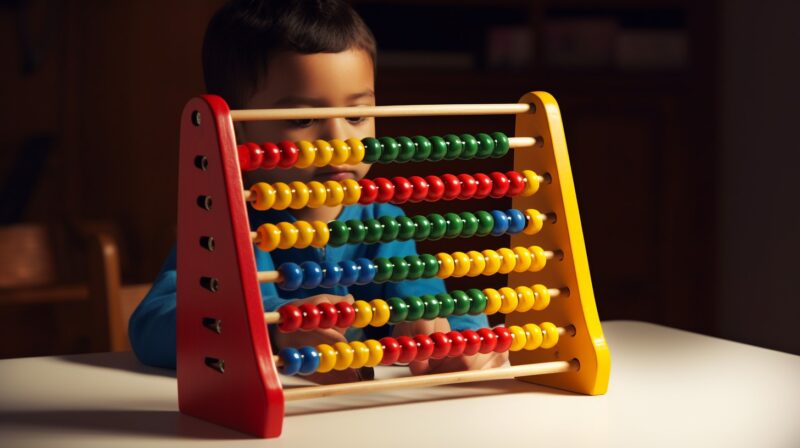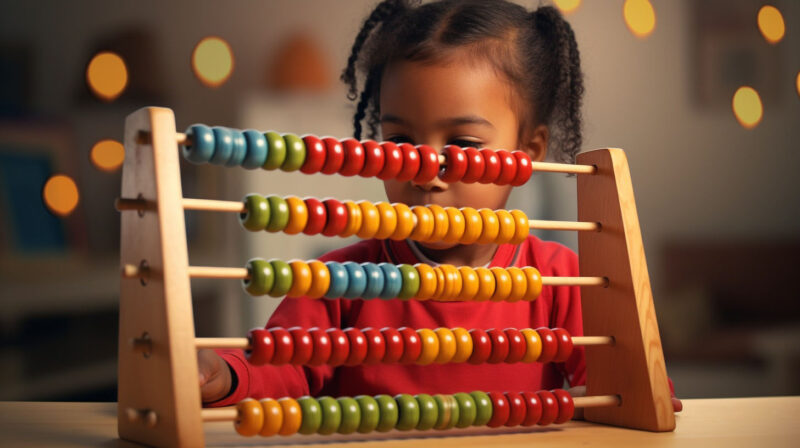The ancient abacus, often seen as a relic of a bygone era, is a treasure trove of educational potential for our young learners. This classic tool, known for its rows of colorful beads, has been the foundation of arithmetic learning for centuries.
But how can we, in today’s digital age, harness its power to benefit our children? This post delves deep into the many engaging and educational activities that can be crafted using an abacus for kids.
Introduction to the Abacus
The abacus, often called a counting frame, is considered one of the earliest computing devices ever created. Its simple design, which has withstood the test of time, consists of beads that slide on rods, making it an intuitive tool for basic arithmetic operations.
According to the Math Learning Center, the abacus has been utilized for centuries across various cultures for its simplicity and effectiveness in teaching basic math concepts. Not just a primitive calculator, it is a versatile tool brimming with potential for tactile and visual learning.
Discovering the Abacus in Everyday Life
Every household item can become an object of fascination for a curious child. Such was the case in my home, where our abacus, gathering dust on a shelf, caught the eye of my eager preschooler. This unexpected moment of intrigue led us down a path of exploration and discovery, revealing the myriad of learning opportunities that this humble tool offers.
- Historical Context: Dive into the rich history of the abacus, exploring its origins and evolution.
- Tactile Exploration: Let your child feel the beads, slide them, and understand the mechanics.
- Color Identification: Use the colorful beads to enhance color recognition skills.
Mathematical Adventures with the Abacus

Basic Counting Skills
One of the foundational skills in early math learning is counting. An abacus offers a tangible and interactive method for toddlers and preschoolers to grasp this essential skill.
According to the National Association for the Education of Young Children, engaging hands-on tools like the abacus can significantly enhance early math learning. The beads serve as visual and tactile counters, making the abstract concept of numbers more concrete for young minds.
- Counting Forward: Slide beads one by one, counting as you go.
- Counting Backward: Start from a higher number and slide beads away to count down.
- Identifying Numbers: Ask your child to show a specific number using the beads.
Simple Addition & Subtraction
Building on counting, the abacus is a brilliant tool for introducing preschoolers to the concepts of addition and subtraction.
Education Resources Information Center says that, using tangible tools like an abacus can demystify abstract math concepts for young learners. The beads offer a visual representation of numbers being added or taken away, making arithmetic operations comprehensible.
- Addition Stories: Craft simple stories where characters “gain” items, and use the abacus to add.
- Subtraction Tales: Narrate tales where characters “lose” or “give away” items, and slide beads to subtract.
Advanced Arithmetic & Pattern Recognition

Skip Counting
Beyond basic counting, the abacus is an engaging tool for introducing children to skip counting. Counting by intervals, such as 2’s, 5’s, or 10’s, becomes an interactive game with the abacus.
Activities that involve patterns and sequences, like skip counting, enhance cognitive development in children.
- Musical Counting: Turn on some music and count beads in rhythm.
- Interval Challenges: Set challenges for your child to count by different intervals.
Beginning Multiplication
Introducing the concept of multiplication to young minds can be daunting. However, with an abacus, multiplication, which is essentially repeated addition, becomes a visual treat.
Visual tools like the abacus simplify complex math concepts for early learners.
- Grouping Beads: Use the abacus to show groups of numbers and explain multiplication.
- Repetition Game: Use the beads to repeat addition and transition into multiplication.
Designs & Patterns

Beyond arithmetic, the abacus is a canvas for creativity. Young children can use the beads to craft patterns and designs, honing their fine motor and visual perception skills.
According to the American Occupational Therapy Association, activities that involve creating patterns boost a child’s motor development and cognitive skills.
- Mirror Patterns: Create a design and challenge your child to mirror it on the opposite side.
- Storytelling with Beads: Narrate a story and let your child represent it using bead patterns.
FAQs
What is the ideal age to introduce kids to the abacus?
While there’s no strict age limit, many parents and educators introduce the abacus to children as young as 2 or 3 years old. The colorful beads can be a great way for toddlers to improve their motor skills.
Are there any safety precautions to consider when using an abacus with young kids?
Absolutely! Always ensure the beads are securely attached to prevent any choking hazards. Additionally, always supervise younger children when they’re playing with the abacus.
Can the abacus be used for teaching other subjects apart from math?
Yes, the abacus can also be used to teach colors, patterns, and even basic principles of physics like movement and balance.
How does the abacus compare to modern digital learning tools?
While digital tools offer interactive features, the tactile experience of using an abacus can be beneficial for hands-on learning. It’s a blend of visual, tactile, and kinesthetic learning.
Where can I buy an abacus for my child?
Abacuses are available at many educational toy stores, bookstores, and online marketplaces. Ensure you choose one that’s age-appropriate for your child.
How can I encourage my child to use the abacus regularly?
Make it a fun activity! Set aside a specific “abacus time” each day, create games, or integrate it into their daily learning routine.
Are there online resources or apps that can complement abacus learning?
Yes, there are many online courses, apps, and tutorials that teach abacus techniques and offer exercises for practice.
Final Words
Embracing the age-old abacus in today’s digitized world might seem counterintuitive. However, its tactile nature, combined with the myriad of learning possibilities it offers, makes it an invaluable tool. Dive into the world of the abacus with your child and rediscover the joy of hands-on learning!
